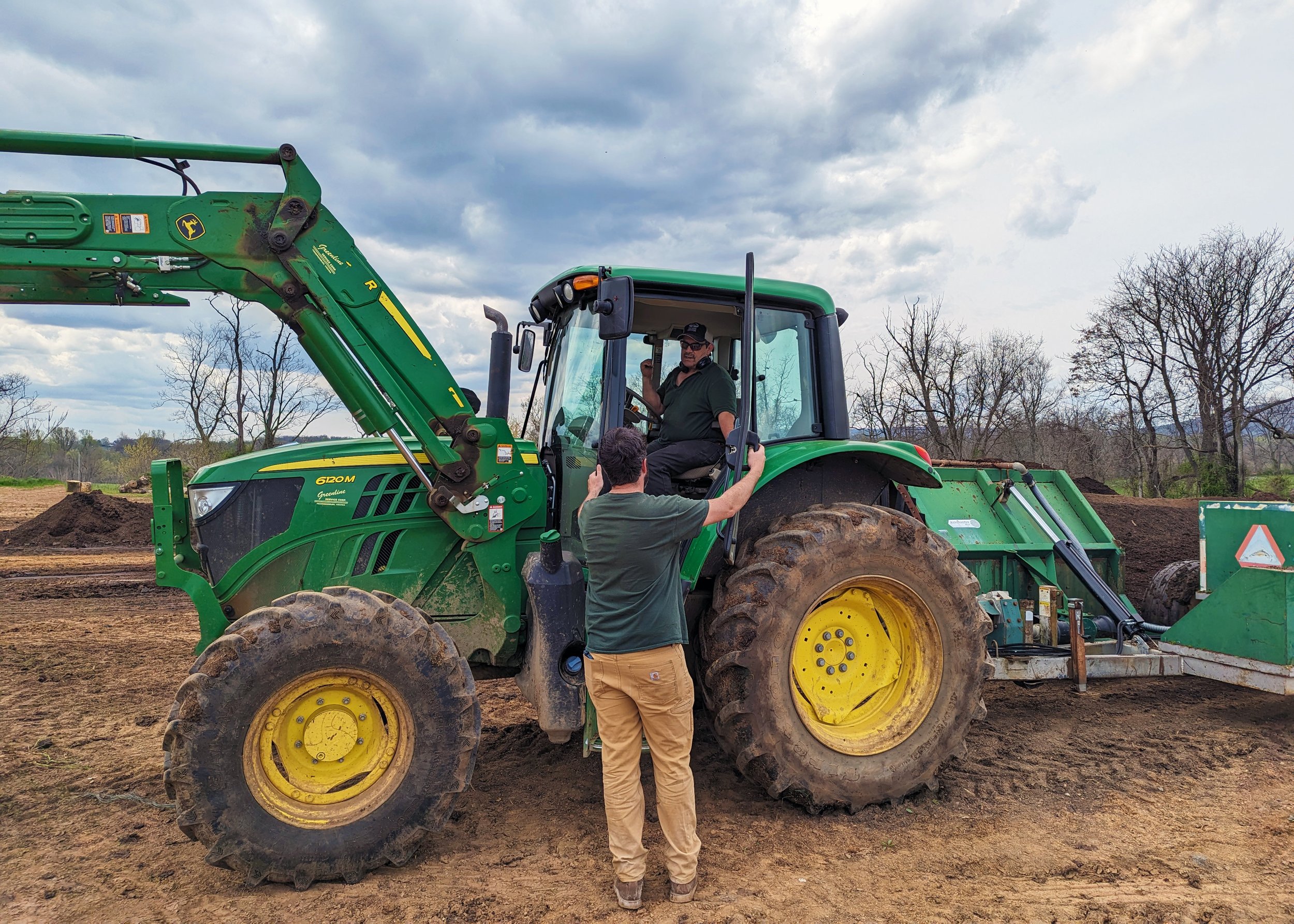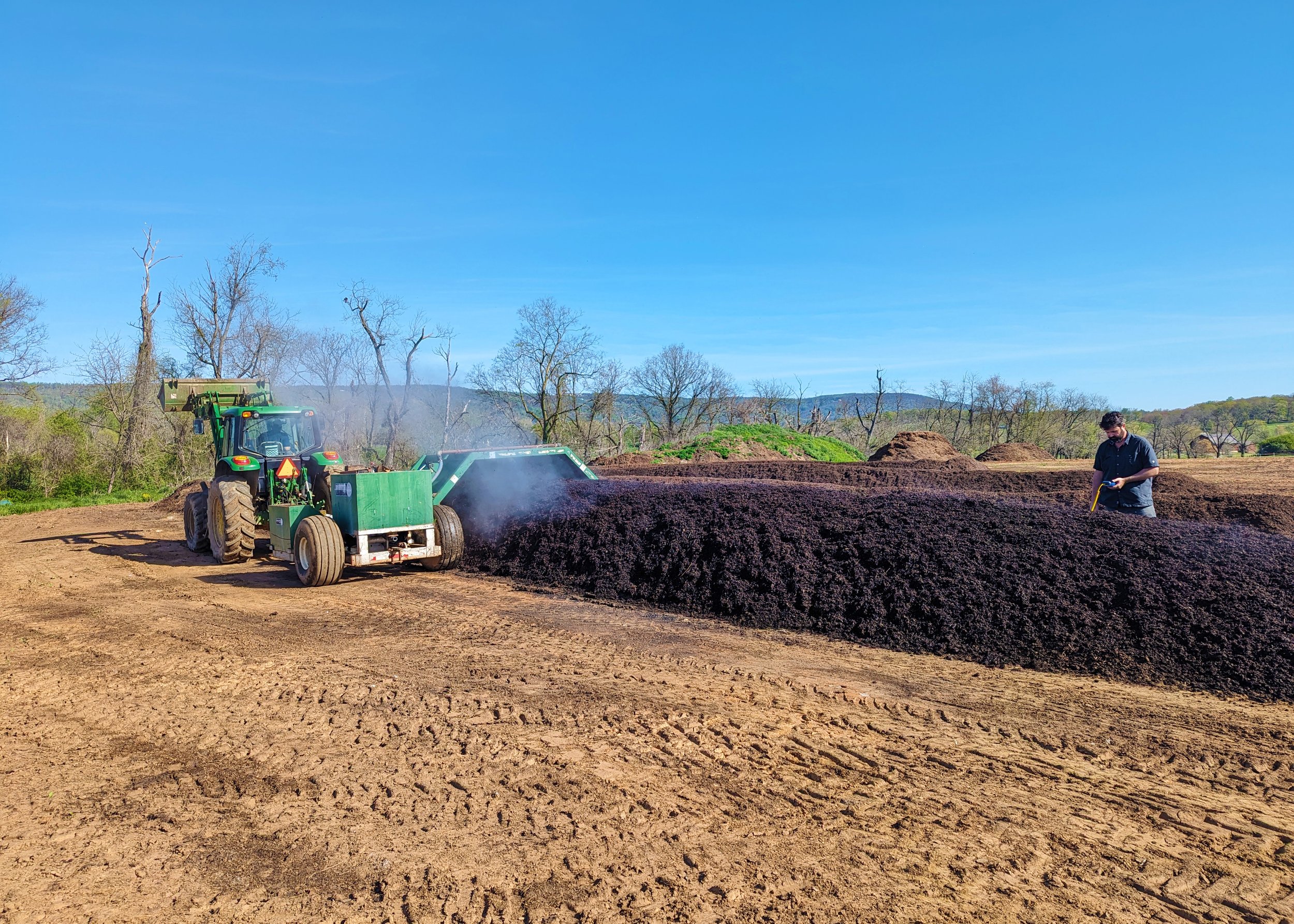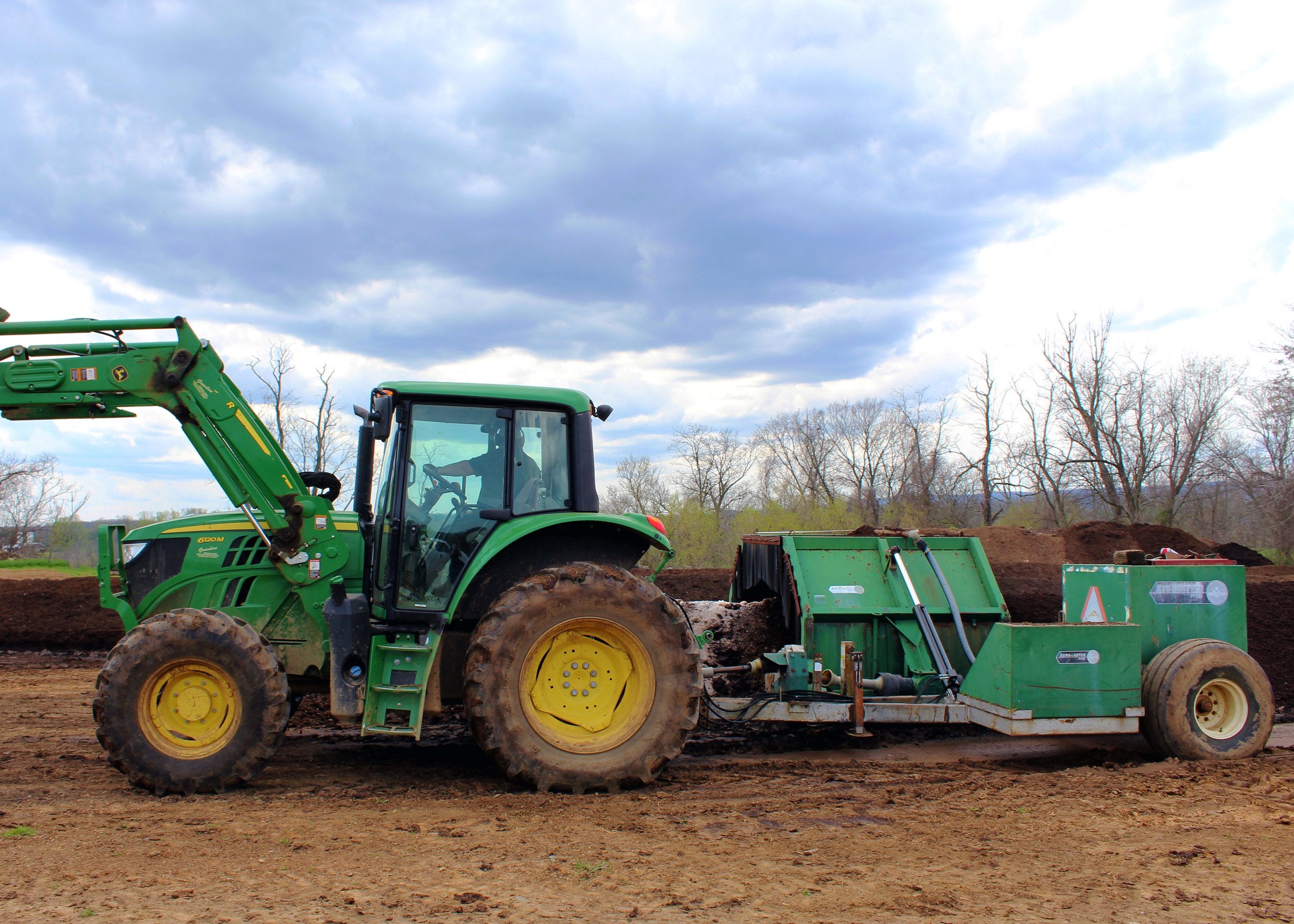Good farming starts from the ground up
Ayrshire Farm’s compost site is a hub of life supporting regenerative agriculture
Ayrshire Farm’s Ismael Cortes Arellano turns a windrow of compost.
This piece is part of the WholeHarvest Year series, which aims to chronicle the farming cycle at Ayrshire Farm.
To the untrained eye, Ayrshire Farm’s compost plot might not look like much: A mostly bare swath of machine-leveled land that’s dotted with piles of dirt, some in tall mounds and others in low, tidy rows. It stands in stark contrast to the 800 acres of lush pastures and vegetation that surround this corner of the farm. Yet, the seemingly unremarkable patch is teeming with life.
Farm Manager Chris Damewood grabs a yellow-handled shovel and breaks open a small cavity in one of the larger mounds. He reaches in with both hands and pulls out a clump of the rich, dark humus that’s writhing with worms.
Red wigglers, he notes.
Chris Damewood, Farm Manager at Ayrshire Farm, inspects a handful of compost flush with red wiggler worms.
The red wigglers are the most visible residents here, but they’re far from alone. There’s a whole community of tiny neighbors – bacteria, fungi, and other microbes – all working together toward a common goal of recycling organic matter into valuable fertilizer.
“You have signs of life here,” Damewood says. “When you see that, you know that life will be there again and that things will grow.”
At Ayrshire Farm, composting plays a crucial role in the practice of regenerative agriculture, where the health of the soil is paramount and farming harmonizes with nature. Composting gives the farm a natural means of improving the land, helping sustain its roughly 460 heritage-breed cattle. The herd is composed of Scottish Highland, Ancient White Park and English Longhorn cattle – hardy animals that live outside year-round and are specifically bred for grazing and foraging rather than high-density feeds. Healthy soil leads to healthy grass. And healthy grass leads to delicious beef.
“If you have good soil health, you have good cattle,” Damewood says. “It’s really that simple.”
Producing the best beef possible is the farm’s top priority. But in many ways, Ayrshire is just as focused on growing grass: equal parts rancher and grass farmer, rooted in the principle that caring for grass by mimicking the natural habits of grazers and the cycles of nature produces healthier animals and healthier meat.
Life-Giving Substance
Today, Ismael Cortes Arellano, primary caretaker of the farm’s compost site, is working a blend of potash, gypsum and a broad-spectrum mineral product called Azomite into a row of compost. At an internal temperature of 160 degrees, the compost is piping hot, releasing a cloud of steam as the tractor slices into the mound.
Once raw material makes its way here, it’s added to existing compost in careful ratios and arranged in windrows where temperature and moisture levels are monitored daily. It sits in those rows for about three months and is churned up as needed with the help of a massive Aeromaster compost turner. It’s then left to cure for about a year, or it can be spread right away on the farm’s pastures, replenishing the soil and grass with vital nutrients following a period of cattle grazing.
Elsewhere on the farm, compost is added to garden beds to nourish vegetables, fruits, and flowers – mana for the many pigs, chickens, pollinators, and people who call this land home.
Other farmers and gardeners throughout the region also depend on this life-giving substance. One such customer is the nearby Oak Spring Garden Foundation. While waiting for her truck to be loaded with compost, Christine Harris, director of the organization’s Bio-Cultural Conservation Farm, says that Oak Spring has been using this compost since 2019 for everything from direct sowing to amending beds.
“It’s really hard to find good, quality compost,” Harris says. “Ayrshire’s is just great and a really nice consistency.”
Christine Harris, of the nearby Oak Spring Garden Foundation, visits Ayrshire Farm for a truckload of compost.
Making Use of What You Have
Almost just as important as creating and sustaining life, compost is also the end of the road for many items at Ayrshire Farm. It’s where spent things go instead of the landfill: grass cuttings and yard waste, garden debris, pine shavings and bedding used by farm animals, as well as manure from poultry, pigs, cattle and horses. Kitchen scraps and food waste from Hunter’s Head Tavern – the farm’s own restaurant just down the road in Upperville – is also sent here several times a week. It’s a luxury many restaurants can’t afford to outsource and one of the simple acts that sets both Ayrshire Farm and Hunter’s Head apart from the pack.
Similarly, the compost site is the final destination for another unavoidable byproduct of farming: unused parts of slaughtered animals, such as organs, offal, bones, hooves and other inedible scraps. While the farm makes a point of trying to use every part of every animal, there are some things that just can’t be consumed or repurposed. At other farms or slaughterhouses, those parts would normally be picked up by a rendering company and turned into tallow, grease, or high-protein meat and bone meal.
Home composters are told they can’t compost meat, and that’s for good reason. It takes an incredible amount of organic matter to break down those parts, and maintaining the proper temperature is a true act of science. The farm is also able to test regularly for bacteria like E. coli and salmonella to ensure everything is safe.



Damewood acknowledges that some people are a little uneasy with the notion of composting meat, but he’s a firm believer in making use of what you have. Meat is incredibly high in nitrogen, which is a crucial component of composting, and many commercial composters rely on bone meal or “hoof and horn” feeds to compensate. Using what the farm already has makes good sense – practically, financially and environmentally. Plus, there’s a certain poetry in this trajectory of life.
“It’s the complete cycle,” Damewood says.
In the end, Ayrshire Farm’s compost site is more than just a patch of dirt; it’s a living testament to the interconnectedness of our planet – a cycle of life, renewal, and stewardship that serves as a beacon of sustainability in an ever-changing world.

